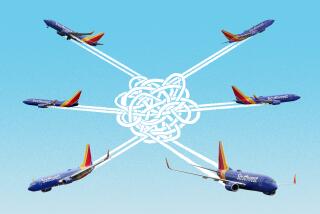Exiting PSA Chairman Recounts the Airline’s Troubles and Triumphs
- Share via
SAN DIEGO — For Pacific Southwest Airlines, 1987 was a year of dramatic change and unexpected tragedy.
It was a year in which the 39-year-old, San Diego-based carrier became part of USAir Group after the completion of a $400-million acquisition.
And it was also a year in which a PSA jetliner crashed, killing 43 people, the second fatal accident in the company’s history.
But for 57-year-old Chairman Paul Barkley, who left PSA last Monday after joining the firm in 1967, the events of 1978 still overshadow those of the past year.
In 1978, PSA suffered its first fatal crash, a mid-air collision with a private airplane over San Diego. That crash, then the nation’s worst air disaster, killed 144 people, including 37 PSA employees.
“We all knew someone on that flight,” Barkley said. “It tore us up.”
Also in 1978, PSA and the nation’s other carriers entered the complicated maze of deregulation that was started by passage of a congressional bill. PSA, an intrastate carrier restricted to flights beginning and ending in California, viewed deregulation as the only way to escape the state Public Utilities Commission’s restrictive controls, Barkley said.
Hamstrung by PUC
“We were trapped in California and (Gov. Edmund G. Brown Jr.) was lobbying to keep us in California,” Barkley said. “We were facing double-digit inflation, but it was taking (as long as) 28 months to get a fare increase approved.”
Barkley, who testified before Congress in favor of deregulation, complained that Brown was painting PSA as the “rich capitalists” who were gouging California’s consumers as they winged their way to record profits.
PSA eventually used what could be described as a loophole to escape from its unwanted role as an intrastate carrier.
As originally proposed, the deregulation bill would have allowed intrastate carriers to escape state regulatory control after more than 50% of their routes became interstate. That provision would have killed PSA’s chances of becoming a federally controlled interstate carrier because even today the bulk of of PSA’s routes remain within California.
But Barkley and other airline executives successfully lobbied Congress to turn intrastate carriers into federally regulated airlines as soon as they flew their first official interstate round trip.
The deregulation bill allowed airlines to serve so-called “dormant routes” that other airlines had applied to serve--but for some reason had abandoned.
Other airlines scurried to find potentially lucrative routes, but PSA scoured the list of dormant routes until they found their opportunity to become an interstate carrier.
Opportunity came in the form of an approved round-trip flight from San Diego to Las Vegas that supposedly was served by Republic Airlines. But Republic actually was flying from San Diego to Las Vegas--with the “return” flight landing at Los Angeles International Airport.
“It had never occurred to anyone that they weren’t providing round-trip service to and from San Diego,” Barkley said with a smile. “It was there, and we used it as an opportunity.”
Federal regulators approved PSA’s application, and “the next morning, bright and early,” PSA’s airplane--with only a handful of paying passengers--made the airline’s first out-of-state flight. The round-trip flight between San Diego and Las Vegas remained PSA’s only interstate flight for some time.
PSA won that battle, but as 1978 drew to a close, the airline’s executives came within a half percentage point of losing a proxy war that might have knocked the airline from the skies.
The battle began when Valhi Inc.--a company owned by Harold Simmons, a Dallas-based investor--began buying heavily into PSA.
The proxy fight occurred during a stormy December, 1978, shareholder meeting, but it wasn’t until two days later that PSA’s management learned that it had kept control of the company by winning 50.88% of the nearly 3 million votes that were cast.
Barkley feared that the Simmons planned to recoup his investment by dismantling the airline and selling PSA’s airplanes.
A major PSA shareholder at the time characterized Simmons as a “corporate gunslinger . . . (and a) Texas wheeler-dealer.” Simmons responded by telling PSA shareholders that “my record is one of building companies, not destroying them.”
PSA later swapped a leasing subsidiary that owned four Boeing 727 airplanes for Simmons’ stock--and cleared a $4.5 million gain on the exchange, according to Barkley.
That swap fit in with PSA’s push to replace its fuel-guzzling fleet with a more efficient one. Coupled with deregulation and a healthy cash flow, the planned fleet renovation left PSA poised for an expansion beyond California’s borders.
But in 1979, “OPEC choked off our oil supplies and our price of fuel rose from $10 million to $110 million,” Barkley said, adding that within a year, PSA’s fuel-guzzling fleet of Boeing 727s was “obsolete.”
(That fuel crunch was reminiscent of an earlier one in 1974 when PSA took delivery of two L-1011 jumbo jets. Then, high fuel prices forced PSA to ground the expensive jets after about six months of service. They sat on a runway for years until PSA finally sold them to a Canadian company.)
Skyrocketing fuel bills, however, weren’t PSA’s only problem during the late 1970s.
The airline also faced annual fare wars along the hotly contested California corridor, high labor costs that left PSA ill-equipped to compete with lower-cost competitors, and the 1981 air traffic controllers’ strike.
“Every September, after the summer season ended, AirCal began the war,” Barkley said. The reduced fares increased the passenger count but increased operating costs.
“We didn’t want to fool with different fare structures because our computer couldn’t handle it and our reservations agents couldn’t handle it,” Barkley said. But PSA eventually joined the growing number of airlines that used computers to generate complicated fare structures.
Halted Service for 1st Time
On Sept. 25, 1980, PSA was hit by a 52-day pilots’ strike that forced the airline to halt service for the first time in its history.
The pilots returned only after then-Chairman William Shimp threatened to replace them.
“We were ready to go,” said Barkley, who was the object of much of the bitterness that spilled out during meetings with PSA employees. “I heard an awful lot about my big salary and my stock options,” Barkley said.
PSA tried to get on track again after that strike, but the airline was floored in 1981 when President Reagan fired many of the nation’s striking air traffic controllers.
“The impact on PSA was double-barreled devastation,” Barkley said. “We stopped growing and we lost our frequency.”
The latter loss was especially hard on PSA, which made its name on high-frequency, low-cost service between West Coast cities.
During 1983, PSA flirted with becoming a national carrier, when airline executives struck an innovative but unsuccessful deal to lease 30 jets from then-failing Braniff Airways. The deal died when a federal court ruled that PSA was not entitled to the landing rights that would have been part of the proposed contract.
In 1985, PSA won a hard-fought battle that produced a 15% pay reduction and a 15% productivity increase. In return, PSA promised its employees 15% of the airline’s stock.
With those hard-won labor contracts and a fuel-efficient fleet, Barkley was telling airline industry analysts that PSA would not fall victim to a rapidly growing merger wave.
But Barkley’s prediction went sour in late 1986 after Newport Beach-based AirCal agreed to be acquired by American Airlines. That deal surprised Barkley because, “I was the guy who should have bought AirCal, but to me, the (asking) price was out of line.”
Nonetheless, within hours of the AirCal deal, Barkley was asking investment bankers to set a price tag on PSA.
“I knew we were going to be in play from the moment that I heard about American,” Barkley said.
But the call from USAir Chairman Edwin Colodny was still somewhat of a surprise. Barkley thought the call would be from Northwest Orient, which had fashioned a far-reaching marketing program with PSA. Barkley also expected to hear from United, which competes with PSA and AirCal in the California Corridor.
Though Barkley left PSA’s payroll Monday, he remains president of the airline’s former holding company, PS Group, which retained ownership of an energy production and distribution company, an aircraft leasing business and a travel agency operation.
More to Read
Inside the business of entertainment
The Wide Shot brings you news, analysis and insights on everything from streaming wars to production — and what it all means for the future.
You may occasionally receive promotional content from the Los Angeles Times.










